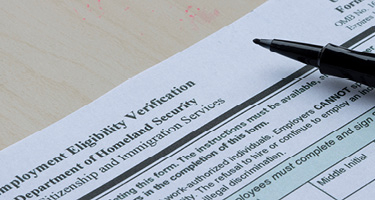Introduction: The Transformative Power of Policy: USCIS Policy Alert PA-2023-18
The precarious intersection of employment and immigration status remains one of the most challenging terrains in U.S. immigration law. For foreign nationals in employment-based visa categories, a sudden loss of employment can precipitate a cascade of complications, extending not only to the visa holder but also to their dependent family members. One regulatory provision that offers a lifeline in such scenarios is the Employment Authorization Document (EAD) under category (c)(35), more commonly referred to as the "Compelling Circumstances EAD."
On June 14, 2023, the U.S. Citizenship and Immigration Services (USCIS) released Policy Alert PA-2023-18, a significant addition to the legal landscape that governs Employment Authorization Documents (EADs) and compelling circumstances. By expanding the scope and defining the nuances of what constitutes compelling circumstances, the policy alert provides a heightened level of clarity and a buffer against the dire consequences of accruing unlawful presence. For legal experts in the field of employment-based immigration and affected workers across various sectors, the policy alert serves as a robust navigational tool through the convoluted maze of U.S. immigration law.
A Perilous Terrain: Unlawful Presence Defined
Unlawful presence starts accruing when a non-citizen remains in the United States beyond the period authorized or without proper authorization. The repercussions are harsh:
- Accumulating 180 days to 364 days of unlawful presence results in a 3-year bar from re-entry.
- Accumulating 365 days or more triggers a 10-year bar from re-entry.
- Accrual of unlawful presence also renders one ineligible for adjustment of status under INA 245(a), making the person removable.
Understanding Category (c)(35) Compelling Circumstances EAD
At its core, category (c)(35) allows certain nonimmigrant visa holders in the United States to apply for temporary employment authorization based on "compelling circumstances." The provision applies to individuals who:
- Currently hold E-3, H-1B, H-1B1, L-1 or O-1 nonimmigrant status.
- Have an approved I-140 Immigrant Petition for Alien Worker.
- Are unable to adjust their status due to visa backlogs.
Defining the Contours of 'Compelling Circumstances'
Before we venture into the myriad scenarios where this policy could prove beneficial, it's crucial to explain what 'compelling circumstances' means. Prior to the policy alert, the term 'compelling circumstances' was ambiguous. The policy alert has now clarified that compelling circumstances could include:
- Serious Illness: Such as a life-threatening disease requiring continuous medical care.
- Unforeseen Economic Hardship: Losing a job unexpectedly due to downsizing.
- Employer Retaliation: Experiencing wrongful termination or other forms of employer abuse.
Moreover, guidance suggests that these circumstances could include factors like significant disruption to the employer, severe economic hardship to the applicant, or other substantial reasons that make it challenging for the individual to maintain their current employment-based status.
Each of these warrants detailed consideration and case-by-case application across visa categories.
Scenario 1: Medical Condition Requiring Relocation for an H-1B Worker
As an illustration, consider an H-1B visa holder who works as a software engineer for a tech company located in San Francisco. She is diagnosed with a rare medical condition that requires specialized treatment available only at a medical center in Boston. Her employer, bound by its own operational constraints, is unable to accommodate a remote working arrangement for her specialized role.
In this scenario, the worker could apply for the Category (c)(35) Employment Authorization Document. Upon approval, this EAD would allow her the latitude to relocate to Boston for her specialized medical treatment. By utilizing the Compelling Circumstances EAD, she can maintain her lawful presence in the U.S. and receive the necessary medical treatment. The ability to invoke compelling circumstances due to illness thus provides both the worker and their derivative spouse a measure of flexibility and security in an otherwise volatile situation.
Scenario 2: Corporate Downsizing for an L-1A Visa Holder
Suppose an L-1 visa holder employed by a multinational corporation is laid off due to organizational restructuring. Facing visa expiry and with no immediate alternative employment, the individual could find themselves and their derivative spouse at risk of falling out of status and accruing unlawful presence. Here, both the L-1 visa holder and the L-2 spouse could utilize category (c)(35) and (c)(36), respectively, to apply for a Compelling Circumstances EAD, thereby maintaining their lawful presence in the U.S. and averting the penalties associated with unlawful presence.
Scenario 3: Navigating Through Financial Straits
An Australian national on an E-3 visa specializing in cybersecurity may face financial hardship due to a volatile economy and project cancellations. Such adverse financial conditions would qualify as 'substantial harm to the applicant.'
Employer Disputes or Retaliation: A Facet of Occupational Hazard
In the context of employer disputes or retaliation, consider an L-1B visa holder disclosing unlawful corporate practices and subsequently facing retaliatory actions, including termination threats or the creation of a hostile work environment. These circumstances may justify a Compelling Circumstances EAD application.
Limitations and Legal Cautions
While the compelling circumstances EAD may stave off immediate concerns about unlawful presence, it is not a permanent solution. Practitioners should be aware that obtaining this type of EAD doesn't confer immigration status or make the applicant eligible for an adjustment of status under INA 245(a). Instead, category (c)(35) EAD serves as a respite because it temporarily halts the accrual of unlawful presence. Think of it as a pause button.
Dependents: Extending the Protection Perimeter
Importantly, the policy extends not just to principal applicants but also their derivative spouses and children. This feature enhances the EAD's value as a protective mechanism extending beyond the principal applicant.
Strategic Recommendations for Practitioners
- Timing: Align the EAD application with other ongoing immigration processes. Misaligned timing can jeopardize an entire immigration pathway.
- Evidence Gathering: Collect as much corroborative evidence as possible. Affidavits from industry leaders or medical professionals can lend significant weight.
- Client Education: Make sure clients understand what the category (c)(35) EAD can and cannot do. This avoids unrealistic expectations and legal complications.
- Stay Updated: Law is not static, especially immigration law. Keep yourself updated on policy changes to strategize accordingly.
Concluding Observations
Category (c)(35) and is an invaluable tool in the immigration landscape. It provides a much-needed buffer against the volatility of the job market and other life events that can disrupt the path toward lawful permanent residence. Yet, as any seasoned practitioner would concur, this category is not a panacea but a component of a multi-faceted approach to navigating the intricacies of U.S. immigration. For those on the turbulent seas of uncertainty, this policy may not be the promised land, but it certainly is a lighthouse providing some much-needed direction.

Fariba Faiz is the founder of the awarded Fariba Faiz Law Offices PC, a practice with a primary focus on employment and investor-based immigration. Admitted to the California State Bar in 1998, she is an unyielding advocate with a proven track record, leveraging sophisticated legal expertise to consistently deliver client success.

































